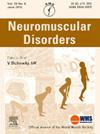Two-year Risdiplam treatment in adults with spinal muscular atrophy: improvements in motor and respiratory function, quality of life and fatigue
IF 2.7
4区 医学
Q2 CLINICAL NEUROLOGY
引用次数: 0
Abstract
Disease-modifying treatments in spinal muscular atrophy (SMA) are emerging. Risdiplam (Evrysdi®) has shown promise in improving motor function in patients with SMA. However, long-term efficacy and safety data in adult SMA patients are limited. Eighteen treatment-naive adult patients with SMA types 2, 3, or 4 received Risdiplam for 24 months. Strength and motor function were assessed through manual muscle testing, hand grip strength, key and tip pinch strength, Motor Function Measure-32 (MFM-32), Revised Upper Limb Module (RULM), Functional Oral Intake Scale, and Neuromuscular Disease Swallowing Status Scale. Patient Reported Outcome Measures included SF-36 quality of life scale, Fatigue Severity Scale, Sydney Swallow Questionnaire, and SMA Independence Scale. Forced Vital Capacity (FVC) and Peak Expiratory Flow (PEF) were assessed over 24 months and analysed retrospectively. Motor function significantly improved, with MFM-32 scores increasing by 2.3 % and 2.6 % at 12 and 24 months (p < 0.01). RULM scores improved significantly only after 12 months (1 point; p = 0.02). FVC remained stable in Risdiplam-treated adult patients, deviating from the anticipated decline calculated from their retrospective data. PEF showed significant improvement after 24 months (6.9 %; p = 0.03). Improvements in quality of life were observed, along with a reduction in fatigue and dysphagia. The safety profile was favorable.
成人脊髓性肌萎缩症患者接受两年瑞斯地普兰治疗:改善运动和呼吸功能、生活质量和疲劳
脊髓性肌萎缩症(SMA)的疾病改善治疗正在出现。Risdiplam (Evrysdi®)有望改善SMA患者的运动功能。然而,成人SMA患者的长期疗效和安全性数据有限。18名未接受治疗的2、3、4型SMA成年患者接受了为期24个月的Risdiplam治疗。通过手部肌肉测试、手握力、键和尖捏力、运动功能量表-32 (MFM-32)、修订上肢模块(RULM)、功能性口服摄入量表和神经肌肉疾病吞咽状态量表评估力量和运动功能。患者报告的结果测量包括SF-36生活质量量表、疲劳严重程度量表、Sydney Swallow问卷和SMA独立性量表。在24个月内评估用力肺活量(FVC)和呼气峰值流量(PEF)并进行回顾性分析。运动功能显著改善,MFM-32评分在12个月和24个月分别增加2.3%和2.6% (p <;0.01)。RULM评分仅在12个月后才显著提高(1分;P = 0.02)。在接受瑞斯平治疗的成年患者中,FVC保持稳定,与根据回顾性数据计算的预期下降有所不同。24个月后PEF显著改善(6.9%;P = 0.03)。观察到生活质量的改善,以及疲劳和吞咽困难的减少。安全概况是有利的。
本文章由计算机程序翻译,如有差异,请以英文原文为准。
求助全文
约1分钟内获得全文
求助全文
来源期刊

Neuromuscular Disorders
医学-临床神经学
CiteScore
4.60
自引率
3.60%
发文量
543
审稿时长
53 days
期刊介绍:
This international, multidisciplinary journal covers all aspects of neuromuscular disorders in childhood and adult life (including the muscular dystrophies, spinal muscular atrophies, hereditary neuropathies, congenital myopathies, myasthenias, myotonic syndromes, metabolic myopathies and inflammatory myopathies).
The Editors welcome original articles from all areas of the field:
• Clinical aspects, such as new clinical entities, case studies of interest, treatment, management and rehabilitation (including biomechanics, orthotic design and surgery).
• Basic scientific studies of relevance to the clinical syndromes, including advances in the fields of molecular biology and genetics.
• Studies of animal models relevant to the human diseases.
The journal is aimed at a wide range of clinicians, pathologists, associated paramedical professionals and clinical and basic scientists with an interest in the study of neuromuscular disorders.
 求助内容:
求助内容: 应助结果提醒方式:
应助结果提醒方式:


